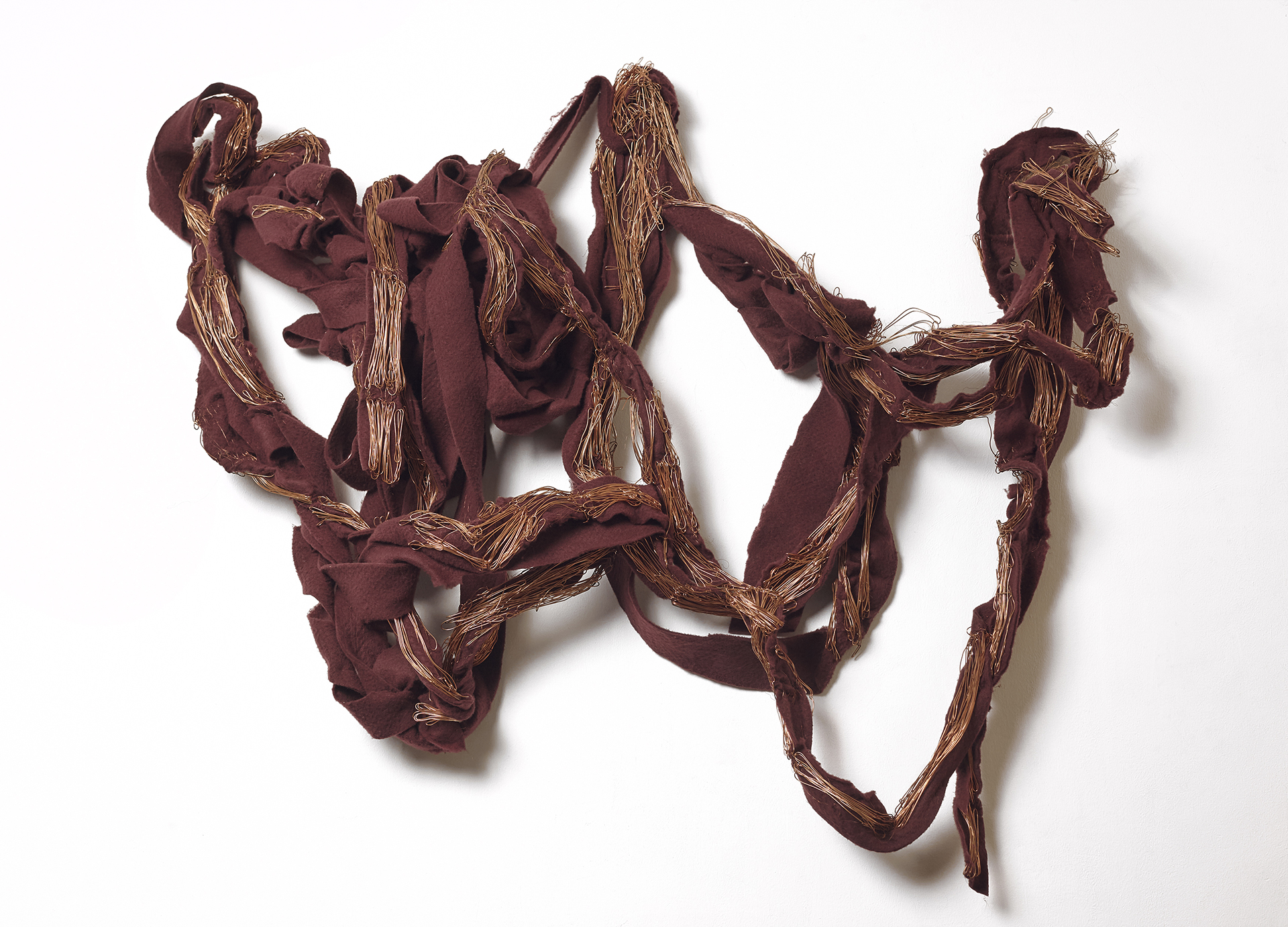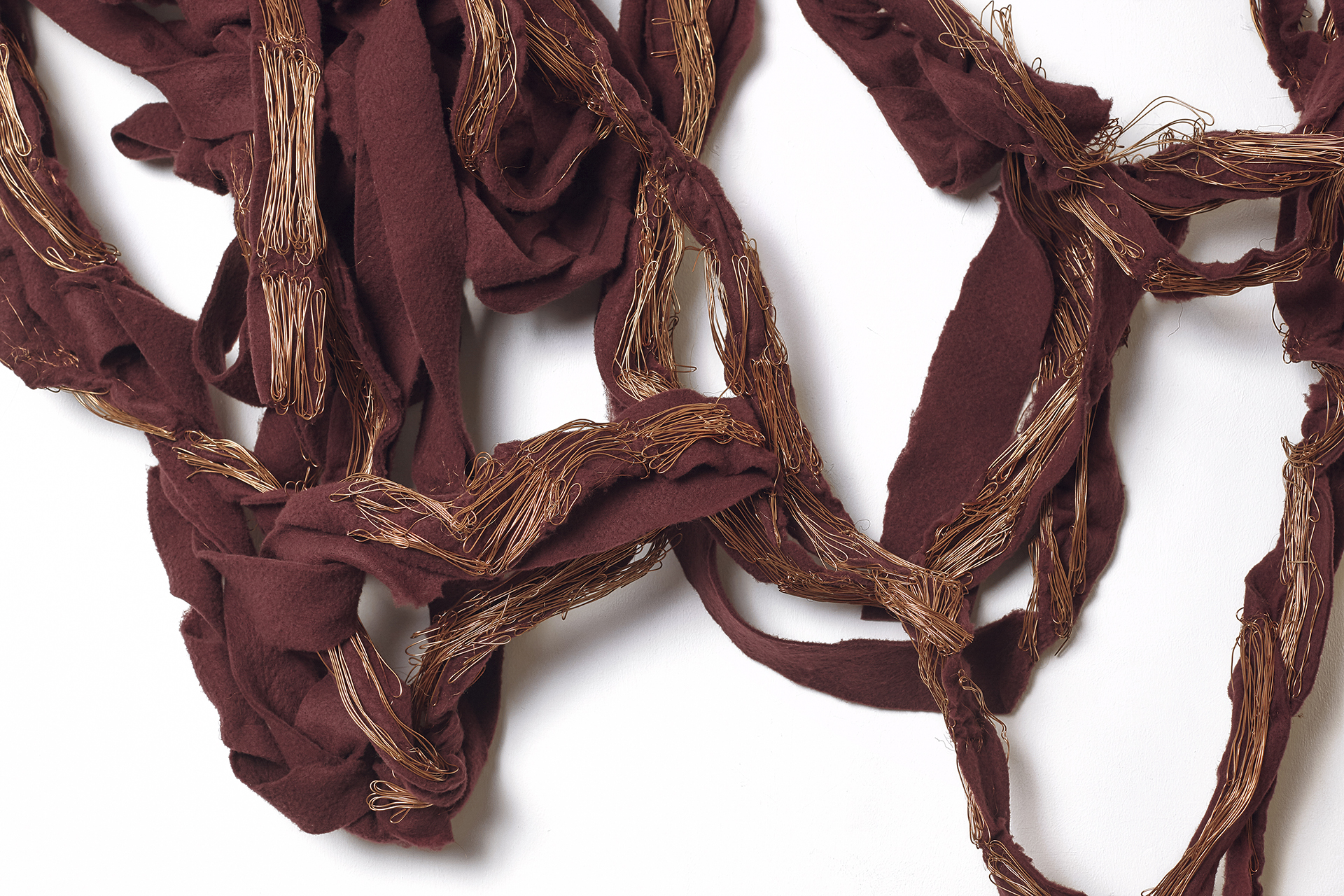
05. Campidoglio
MITAD CENIZA MITAD LATIDO
Jaime Bedoya
-----------------------------------------------------------------------------
Artista total, renacentista contemporáneo: eso era y eso es Jorge Eduardo Eielson (Lima, 1924 - Milán, 2006). Poeta, dramaturgo, periodista y artista plástico, dejó sembradas una serie de interpretaciones del mundo interconectables en el tiempo y en el espacio. Estas redes tienen como punto de encuentro una unidad mínima de tensión y posibilidad, el nudo.
La obra abierta de Eielson hace posible establecer nuevas vinculaciones con una sensibilidad diversa que al mismo tiempo es profundamente íntima. Se trata de nuevas capas de aproximación a lo que nos relaciona como materia y como forma. Eso lo que acá presentan Elisenda Estrems y Nani Cárdenas, una nueva forma de anudar con la obra de Eielson: sus
nudos siguen ofreciendo infinitas maneras de enlazarnos con la vida.
Nani Cárdenas
El desarrollo de la propuesta de Cárdenas se nutre de un Eielson sensorial. Este, como poeta y como artista plástico, describe una materialidad de infinitas posibilidades, incluido el vacío que todos ocupamos.
El nudo es el inicio de la investigación: alianza e impulso que todo conecta, logrando un dibujo aéreo, si es que no mapa de cercanías y de distancias. Estos ritmos internos de la materia hacen una danza paralela donde lo que tocan, es. A partir de formas que se repiten de manera acumulativa Cárdenas revela coincidencias antagónicas: el brillo debajo de la piel.
usted no me creerá
pero luchar luchar luchar
todas las noches con un tigre
hasta convertirlo en una magnolia 1
La materia en la que aparecen estas formas es una revelación no dicha. El acrílico transparente es invisible y reflejante a la vez. Hay memoria de huaca milenaria en el metal que simula un traje pixeleado. Mientras que lo que queda del cobre después de acuñar monedas transforma la falsa nostalgia por el dinero en una ensoñación galopante: Soñar solo caballos.
••••
Una materialidad explícita conecta primigeniamente los trabajos de estas dos artistas plásticas. La estera del Petate de Estrems, que recoge el primer Eielson básico y cotidiano, dialoga con las sillas y escaleras metafóricas de Cárdenas escapadas de un poema. La rigurosidad del abecedario en gris creado por Estrems para recitar a Eielson, piel debajo del brillo, contrasta con la sensualidad del dibujo que en Cárdenas muta entre lo escultórico y lo pictórico. Las diferencias complementarias conforman el todo.
Este juego estelar, blanco y negro que no cesa, encuentra su dinámica y empatía en el afán de conectar poemas con procesos. Es el tema de origen —la polisemia poética de Eielson— lo que hace posible la convivencia de miradas distintas al revisitar sus palabras. Entre ambas visiones lo que perdura es la permanencia de una verdad en espiral, arte poética que ocupa la sala que ahora nos rodea:
Somos un animal que se enamora
Mitad ceniza mitad latido
Un puñado de tierra que respira
De incandescentes materias
Que jadean y que gozan
Y que jamás reposan 2
_____________________________________________________
1 Campidoglio, Jorge Eielson, 1952.
2 Ceremonia solitaria en compañía de tu cuerpo, Jorge Eielson, 1964.
Acontemporary renaissance, an absolute artist: that was and that is Jorge Eduardo Eielson (Lima, 1924 - Milan, 2006). Poet, playwright, journalist and plastic artist, he left sown a series of interpretations of the interconnectable world in time and space. These networks have as a meeting point a minimum unit of tension and possibility, the knot.
The integral work of Eielson makes it possible to establish new connections with a diverse sensibility that at the same time is deeply intimate. These are new layers of approaches to what relates to us as matter and as form. That is what Elisenda Estrems and Nani Cárdenas present here, a new way of knotting with the work of Eielson: his knots continue to offer infinite ways to entwine ourselves with life.
Nani Cárdenas
The development of Cárdenas’s proposal is nourished by a sensory Eielson — who, as a poet and plastic artist, describes a materiality of infinite possibilities, including the emptiness that we all occupy.
The knot is the beginning of the investigation: the alliance and impulse that connects everything, creating an aerial drawing, becoming a map of proximity and distance. These internal rhythms of matter make a parallel dance where what they touch, is. As a result of cumulative, repeated forms, Cárdenas reveals antagonistic coincidences: the brightness underneath the skin.
you will not believe me
but fight fight fight
every night with a tiger
until turning it into a magnolia 1
The matter in which these forms appear is an unspoken revelation. The transparent acrylic is invisible and reflective at the same time. There is the memory of a millenary huaca in the metal that simulates a pixelated suit. And what remains of the copper after coining transforms the false nostalgia for money into a galloping daydream: Dreaming only horses.
••••
An explicit materiality connects primitively the works of these two plastic artists. The mat of Estrems’s Petate, which compiles a fundamental and early Eielson, dialogues with Cárdenas’s metaphoric chairs and stairs, which seem to have escaped from a poem. The precision of the gray alphabet created by Estrems to recite Eielson, skin underneath brightness, contrasts with the sensuality of the drawing that in Cárdenas mutates between the sculptural and the pictorial. The complementary differences make up the whole.
This stellar and monochromatic game, which does not cease, finds its dynamic and empathy in the eagerness to connect poems with processes. It is the matter of origin — the poetic polysemy of Eielson — which makes possible the coexistence of different views when revisiting his words. Between both visions, what remains is the permanence of a spiral truth, a poetic art that occupies the room that now surrounds us:
We are an animal that falls in love
Half ash half heartbeat
A handful of earth that breathes
Of incandescent materials
Who gasp and enjoy
And never rest 2
_____________________________________________________
1 Campidoglio, Jorge Eielson, 1952.
2 Ceremonia solitaria en compañía de tu cuerpo, Jorge Eielson, 1964.

